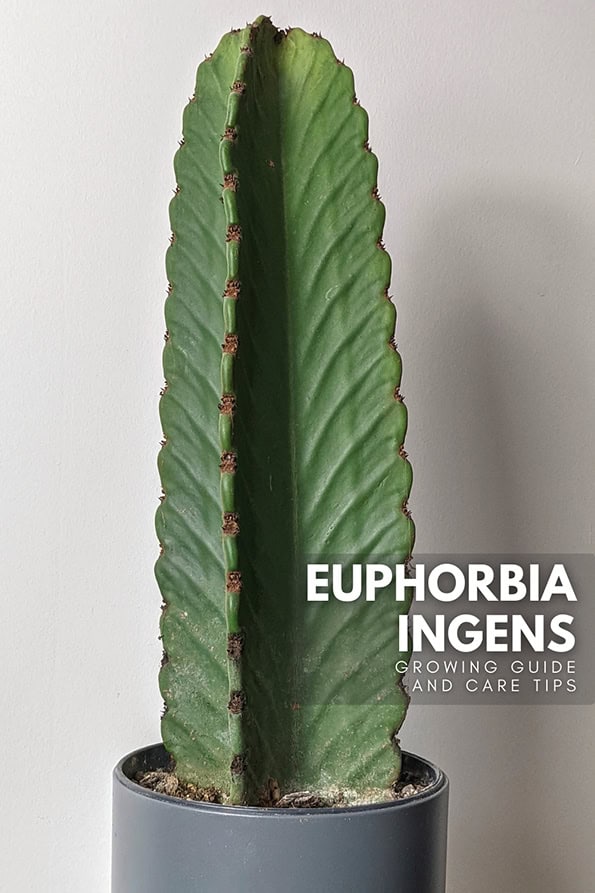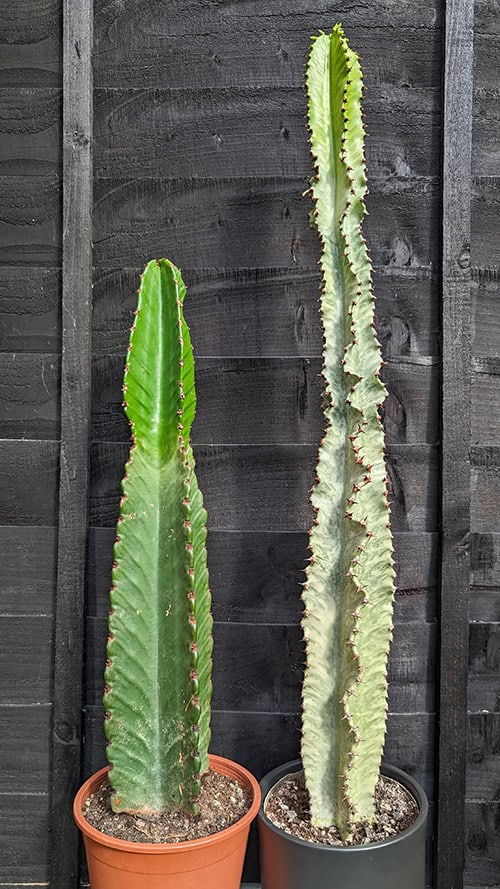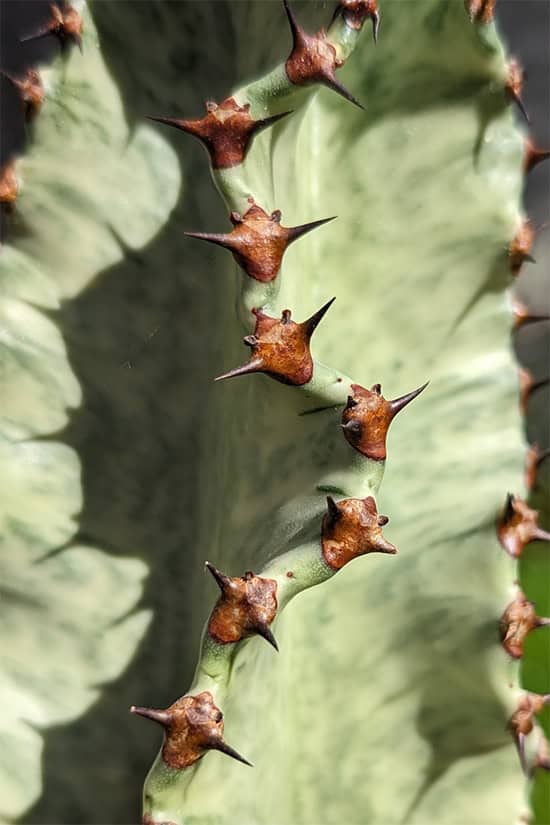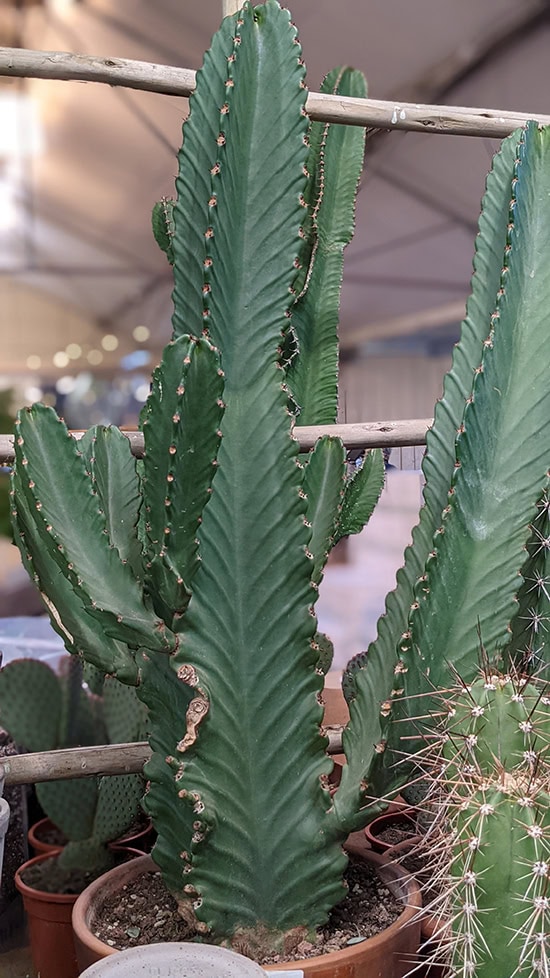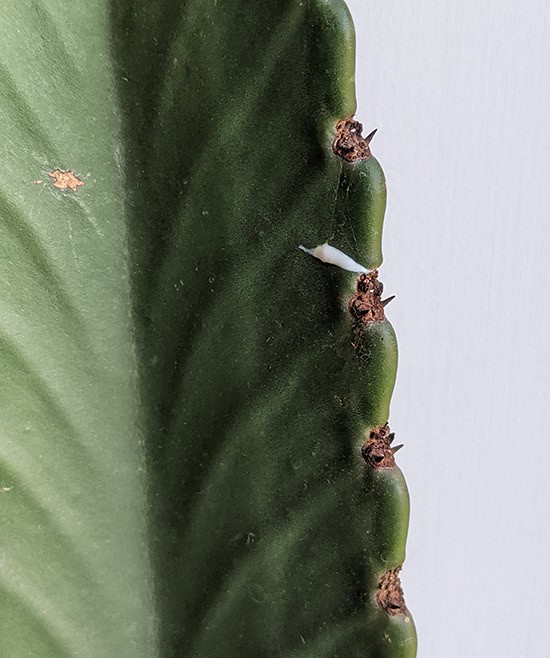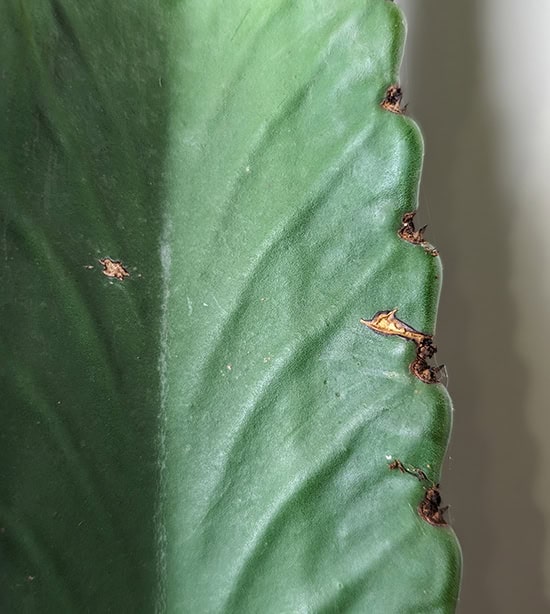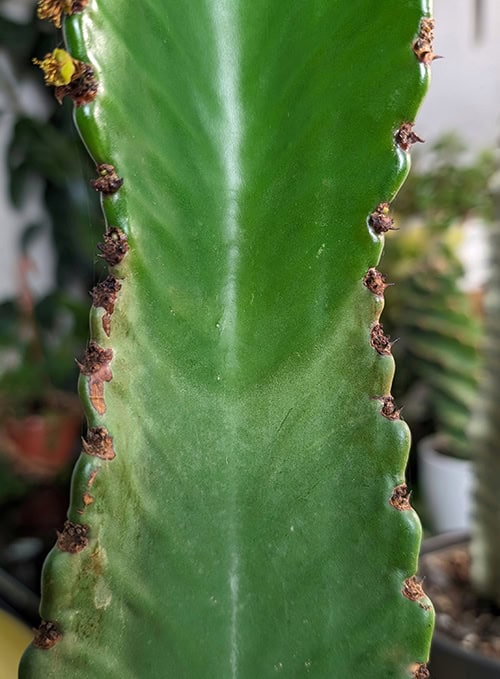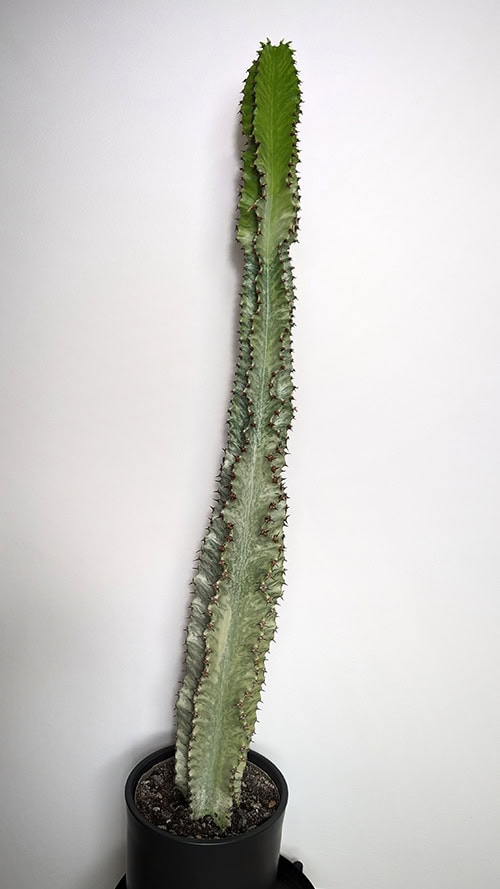Euphorbia Ingens, sometimes known as the Candelabra Tree, is a bold structural houseplant with an extremely thick ribbed stem. With good care, it will eventually become a sizable and impressive plant.
They can be on the pricey side to buy, even when quite small. However as long as you've had some basic experience with growing succulents, the Euphorbia Ingens easy going nature means you shouldn't run into many problems and consequently is often worth the investment.
Euphorbia ingens, also known as the "Candelabra Tree", "Candelabra euphorbia" or "Chocolate Drop Cactus" is a succulent tree native to Southern Africa. Despite its cactus-like appearance, it belongs to the Euphorbiaceae family rather than the Cactaceae family.
Euphorbia ingens can reach impressive heights, 30 feet or more in its natural habitat. However indoors it will grow slowly and be restricted by the size of the container. They will take many years to outgrow your home (if ever), so if you care for it properly, you could have an extremely structural houseplant for decades to come.
How do you pronounce Euphorbia Ingens correctly? Say:
yoo-FOR-bee-uh IN-jenz
The main problems you'll face with these plants will be caused by insufficient light and overwatering. This plant won't compromise on either of these things so you need to get on top of these needs as a priority. I'll talk more about this in my Euphorbia Ingens care instructions shortly.
Just a quick note of caution. Like almost all Euphorbia, there is a latex sap running through the entirety of the plant. If you damage it then the sap will flow. Take precautions if you do anything that will intentionally damage the stems, such as pruning, propagation, moving a large plant, etc. Both for you and the plant.
Generally, the all green Euphorbia Ingens is the more popular version of these plants. But you can get a beautiful and unusual variegated version for a little more money. Or you could do what I did and get both.
The typical size that you can often pick up from garden centers and nurseries. The all green variety on the left and a striking variegation type on the right.
Unfortunately the variegated version is often mislabeled and is actually another species of Euphorbia called Euphorbia Ammak (it's often labeled as Euphorbia ingens Variegata, Euphorbia ingens marmorata or Euphorbia ammak Variegata). It's not big deal as the care needs are the same, but if you're curious about what you actually have, here are the key differences between the two species.
Click the photo below for an interactive summary.
Euphorbia Ingens
The scalloped ridges on the stems of the Ingens almost always grow straight, but on the Ammak they tend to have a wavy growth (a few straight sections are normal). The thorns are less developed on the Ingens but on the Ammak they're very prominent and obvious.
There are very visible ribs on the stems of the Ingens but on the Ammak they tend to be much softer or nonexistent. This can be harder to see on the variegated variety anyway due to the coloring, but side by side you can feel the difference using a finger.
Click the photo below for an interactive summary.
Euphorbia Ammak
Even with my pointers above some confusion is normal, especially if you're buying quite a young plant. The good news is they need the same care to perform well and all of what you need to provide is detailed next.

Hi, I'm Tom!
If you're like me and enjoy the challenge of growing houseplants and getting them to thrive, then Ourhouseplants can help. This website shares my knowledge and years of growing plants and provides (hopefully) helpful advice on properly caring for your indoor plant friends.
On the surface, they seem like adaptable plants as they will cope for months or years in lower light areas. But this comes with a huge cost in terms of how it grows. With insufficient light the new growth will be etiolated (more about this here).
Your plant needs full direct sunshine for at least a few hours a day. Ideally longer. My variegated plant sits right next to a West facing window and gets two or three hours of direct late afternoon sunlight. It's still not enough, this years growth has come in etiolated. I need to move it somewhere with more light or put it outside during the Summer.
The plant will accept less than ideal light conditions but it won't grow correctly. As much full sun as possible is wanted.
Pay attention to your environmental factors.
Everyone has different growing environments and these can change over the year. You must adapt your watering routine when needed.
During Summertime, plants growing outside in full sun and in a good free draining potting mix will need a lot more water than the same plant over Winter, growing inside and receiving only bright light.
Most Euphorbia tend to be thirsty (when grown in full sun), and you'll need to water your plant regularly during the warmer months of the year. Most of mine get a reasonable amount of water twice a week, or one through deep watering.
The key here is to water it and then don't do it again until the potting mix has dried out. How long that that takes determines the frequently of how often you need to do it.
In early Spring, late Autumn and over Winter you should wait a week or two after your plant has dried out before watering again. You will cause root rot if you don't let your plant dry out or you overdo it.
You don't need to be concerned about humidity levels with these houseplants. They can put up with anything found in the average home.
Fertilize your plant whenever you notice it growing. This tends to start as you head towards the middle of Summer before stopping when getting towards the middle or end of Autumn.
Some people will feed all year round regardless if the plants growing or not. I don't do this as I think it's too much, and it can increase the risk of fertilizer burn, damaging the roots and making it harder to perform its usual biological functions.
Cold temperatures below 10°C (50°F) will risk slight damage to the plant. Anything close to freezing will cause serious problems. There is no upper temperature in your home that will be too high for it.
If you feed your plant a few times each year, they don't have to be repotted regularly.
Repotting is almost always done because either the plant has grown so tall the current planter is unstable or the plant has stopped growing for a long period. Generally, succulents are quite happy in small pots, but once the roots have reached the edges of the container they stop growing.
They'll be okay to be frozen in time like this for a few years, but most people who grow houseplants want them to grow larger over time. So once the existing container is too small or the plant keeps tipping over, it's time to repot it.
Watch my YouTube video to see these plants in more detail. I've used lots of diagrams and footage of my plants. I hope it's helpful, please let me know what you think.
Euphorbia Ingens will be happy in a variety of soil mixes. They'll grow in normal potting compost but this drastically increases the risk of root rot. You have to be so, so careful.
Instead, using a free-draining and gritty potting mix is much safer. You can often buy it ready-made, or you could make your own. Here is my article on the subject and what works best.
If you want to propagate, stem cuttings are the way to go. Usually this is a case of removing the top section of a stem, then letting the raw edge dry and callous over for a few days. Once this has happened, plant it a inch or so down into a well draining gritty potting mix. It's important the part above the soil doesn't wobble around too much when planted up, or it may not root.
Top Tip
If your Euphorbia has etiolated growth and you want to remove it, you could use some of this to propagate a new plant instead of just discarding the removed plant material.
You'll get best results doing it during early Summer when there is more light around and the temperatures are warmer.
If you try it at other times of the year the plant may not do anything or grow roots for months. In theory this isn't a problem, but the longer the cutting is "waiting" for the right growing conditions, the greater the chance of it rotting or never rooting.
Growth is very obvious as it happens extremely fast. However it tends to only happen over a few months each year, typically mid summer until the middle of Autumn. New growth will initially be a different shade of green. More on this here. After that the plant will appear to go dormant and won't grow, much or at all.
It's still busy creating energy, so continue to treat your plant right, and come the following year, it should sprint off again.
If you live in a temperate region, have a grow room, or something similar, your plant may grow all year round.
Smaller plants tend not to have "arms" but with good care and some maturity they're reasonable common (and extremely handsome).
Grown outdoors in the ground, in their native habitats they'll become huge trees. Indoors they will be restricted by root space and will never reach these sizes. Anything from a few feet to ceiling height is considered normal.
You can increase the size by repotting, and providing strong direct sunlight during the day. Tall plants can be controlled with careful pruning (you can even use the cuttings to create new plants).
They'll often flower during the Summer if they're getting full direct sunlight. Normally the plant needs to be moved outside for this to happen, but I have heard of people getting blooms on indoor grown plants too.
The flowers start off as small green balls before producing little flowers like this. Some have a scent but it's not overly powerful. They'll last a few weeks before dropping off.
The thorns on the stems can cause some fairly deep scratches, so if your pets like to play with plants, you need to keep this one away from them.
Additionally, the sap can be irritating to eyes and is mildly toxic if consumed in larger amounts. Fortunately, the taste is extremely unpleasant, and any pet should be deterred from their first bite. Only you know how your pet responds to your houseplants, and you'll need to decide for yourself if they're suitable to live alongside your companions.
Latex Sap.
Euphorbia plants produce a white sap. Its purpose is to protect the plant from pests and prevent pets trying to eat it. It also dries and will form a type of callouses over any wounds that occur, much like we form scabs.
If you ever get a few drops on your skin, the sap is reasonably benign for most people. But it will react negatively if it gets into your eyes and some individuals will find it irritating to be on skin.
You need to think about wearing gloves and eye protection if you're going to be handling the plant aggressively, for example pruning or propagating. The majority of people who have problems are those who are cutting the plants without eye protection (as these three individuals found out). Be safe.
The milky sap appears whenever the plant is damaged. It will harden and protect the plant. If too much oozes out you can run it under cold water for 10 seconds to make it stop. Avoid getting it on you, as it can cause irritation.
Corking.
Brown "scars", in either small sections or spread over large areas are quite typical for succulents. It's a normal "healing" function of the plant and can't usually be prevented or reversed.
Even in ideal conditions, the plant can still be accidentally damaged. Take care of it and choose it's location in your home carefully to prevent avoidable corking.
New Growth Different Color.
Like many succulents, new growth tends to be produced super fast during its growth spurt. This speed often means the new areas are relatively quite soft and juvenile. On the Euphorbia Ingens you will see this as a lighter shade of green on the all green variety and on the variegated version, the variegation is initially less prevalent.
In time, both plants will change this new growth and blend in with what has already grown. However, this process can take well over 6 months in some cases.
New growth is a lighter green, but will harden up and darken up over the following 6 months.
Rot.
The roots and stem can easily rot if overwatered. This happens more often over the winter months as the plant needs less water and the potting mix will take longer to dry out. Reducing the amount of water you give your Ingens over this period will help massively. Using free draining potting mix and ensuring any excess water can drain out of a hole in the bottom of the container will all help too.
Extremely cold temperatures can cause damage to the cells in the plant and this can cascade causing random sections going soft and rotting.
In all cases the Ingens will fall apart if you don't act quickly. Check out my how to save an overwatered succulent guide if this is happening.
Etiolation.
It sounds like a complex term, but etiolation is just a term for thin, leggy, and elongated growth.
It's a problem with succulents and cacti as they typically should have thicker stems and once the bulk of this new growth has been grown it "locks" into place and won't thicken up later.
Note the top section of this plant is thinner than the bottom section. Although it could be worse looking this is still etiolation. It can be a common problem for an indoor plant as light levels tend to be lower. If it's still happening even in a bright location, moving it outside during the Summer could help.
Etiolation is permanent, so you cannot make a succulent grow thicker where it is already etiolated. The only solution is to stop it from happening in the first place. The cause is almost always down to insufficient light. Bright light is often not enough to prevent this problem in Euphorbia Ingens, these plants must receive direct sunlight for several hours a day during the growing months of the year.
If you've just discovered your plant has this problem and you're worried about having a weird looking shaped stem in the future, you can cut off the etiolated growth. New "arms" should sprout from the cut area. You could also try and propagate the removed growth.
